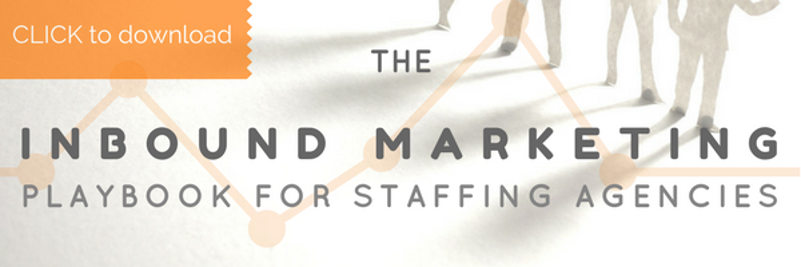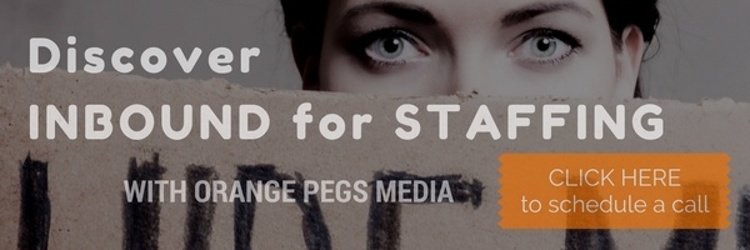Start with Less of the same
A lot of temporary and direct-hire agencies are still holding onto the idea that more of the same is the way to overcome their sales woes. Meaning, more ads and touchy-feely initiatives combined sales people knocking down more doors, sending out more social media blasts, hammering out more cold calls, and making more general noise.
But I don't think the old system works very well anymore. The internet has changed the way we find resolutions to our problems, empowering us to take the lead. No longer do we rely on ads and cold calls to tell us what buy or care about.
This is why I think it's time for you to take a serious look at inbound marketing.
Here are some sales challenges I know your account executives are facing, and how you can help them tilt the scales in the other direction with inbound.
Let's define "inbound marketing."
I have heard a lot of different ideas of what inbound marketing is over the years. In fact, I was on the phone just today with a prospective client who used an "inbound marketing" service last year that essentially directed inbound traffic and leads to their website. The traffic came through ads and landing pages developed by the agency, but the client didn't actually own any of the IP, nor did any of the content marketing occur on their website.
They never even saw the marketing that occurred. They just hit the "on" switch, and the leads began flowing.
The moment the client decided not to work with them anymore (there were many reasons - expensive, broad focus brought uncomfortable clients, etc) all of the benefits disappeared. There was no way to find the landing pages or any of the marketing collateral, and at one point, they started getting calls from people looking for a competitor. Sounds to me like the agency was in the business of recycling marketing collateral that pointed to THEIR website, then filtered through to their clients, which is why they owned all of the rights to the IP.
Technically speaking, yes, they created a flow of leads to the website that were coming in to them, however, this isn't "inbound marketing" by any real definition of the term.
True inbound marketing does three things:
- Attracts visitors to your website
- Converts visitors into leads
- Nurtures leads into being sales qualified or customers
True inbound puts your target audience first. So, the first thing we do when kicking off a new project is develop the top 1 - 3 buyer personas (more on personas HERE). These are what we build our entire program around.
Once we have the foundation set, we start thinking about content that addresses the pains experienced by your personas at the three different stages of the buyer's journey:
- Awareness stage
- Consideration stage
- Decision making stage
(MORE LIKE THIS: How Inbound Marketing Influences the Buyer Decision Process)
THE FORMULA:
We want to attract people in all three stages with white-hat SEO, social media marketing, blogging, and an optimized website. We then find ways to convert them into leads by offering content downloads in exchange for contact information.
Once they are leads, we nurture them based on where they are in the buyer's journey using email marketing, automation, sales alerts, and integration with other sales tools.
That's the 80,000 foot overview. If you want to learn more about inbound and how it applies to the staffing industry, check out this free playbook:
Now, let's talk about two of the biggest sales problems your contract or direct-placement recruitment agency faces and how inbound marketing will help you meet them head-on.
PROBLEM 1: High turnover
High turnover is creating more problems than you may realize
A study was published in 2014 by the American Staffing Association talking about some of the trends in staffing, which included statistics around turnover. According to the study (previous citation link is broken--please leave new citation in comments), the turnover rate in staffing is nearly 300%!
This is terrible news! Not only does high turnover come at a cost with your unemployment bureaus, but it's also costing you clients - new, old, and FUTURE clients!
What does turnover have to do with it?
PROBLEM 2: No Brand Loyalty
It's a domino effect
Your customers are your customers because of the relationships they establish with your sales and service teams. Unless you're running the business AND fulfilling and selling and running billing, you can't be in front of the client at every interaction with your company.
So, if you want your customers to stay loyal to you, you are expected to stay loyal to them, which means making sure they're not dealing with a new contact at your agency every 3 months. It means hiring the best talent and having a process in place that works, and drives honest value.
A POWERFUL SOLUTION: What does Inbound have to do with it?
Granted, I don't think inbound is the answer to resolving your high turnover issue by itself, but it's definitely a start, and a really good start at that.
For one, you'll be providing your sales teams with inbound leads. They will ALL love you for that, because it means their quotas are more realistic, and it makes them feel like your company actually cares about their individual success.
Every one of your competitors talks about caring for their employees, yet, they have the same unrealistic expectations, pushing the same, tired sales agendas, achieving the same disappointing results... You, however, can do a lot better and show your people that you care by providing a constant flow of inbound leads with real potential to close.
That's not normal... Ask anybody.
This leads us to brand loyalty
If you decrease turnover, you increase client retention, because your clients are less likely to go wherever your recruiter lands.
Okay, but there's more to it than that. And there ought to be, since we'll never completely rid ourselves of turnover. With inbound marketing (and growth driven design), we're actually helping you personify your agency, so it and your website become members of your team.
And you never have to worry about turnover with your brand or website. Those are yours as long as you keep filing the right paperwork and paying the right bills.
So, how else do the different components of inbound contribute to happier sales teams and more loyal clients?
The language on your website should match the language your customers are using to find answers to the problems you solve.
With inbound, we focus all of our content around keywords that the data and research says people care about, and that our brands can fulfill. It becomes less about selling, and more about helping, a concept that will make even your most obstinate prospects finally let you in when they see that it's real, not just lip service.
We use our SEO strategy to answer questions and share stories about the pains our best customers experienced prior to coming to us. By doing this, we create many paths for people to relate to, which makes the discovery process more enjoyable and relevant.
For your sales people, it provides content they can share that is non-disruptive and welcome. For your brand, it creates a familiar voice and face (if you're willing), positioning you as an expert in the field and viable solution.
We continue using the language found in our SEO strategy, and get involved in the bigger-picture discussion around the problems your agency solves. We distribute content published by others, our own blog posts and content offers, the occasional ad, and we generally make it easier for people to find and validate your company, and for your sales people to share your content.
Your sales people are connecting through LinkedIn and other social channels, and that's replacing the need for a Rolodex. It's also replacing the need to have YOU around if you aren't on top of it.
But if you're visible and present on social media, people will notice, and you will win their loyalty.
There is nothing like being able to provide value outside of the services your agency offers.
During the Great Recession, I was working as an AE for an accounting, finance, and IT staffing agency. When businesses started bouncing back, I noticed that most were unwilling to bring in outside help or hire anybody new despite their existing employees working full time.
It was a cost issue. They were terrified, like everybody else out there, to invest in staff when the future was so uncertain.
The problem, however, is that the costs associated with overtime pay were becoming a problem for many, so I created Excel calculators helping them determine the right point in time to bring in temporary help.
I can only imagine how much further I would have gotten and how much longer I would have stayed if these marketing materials were coming from corporate instead of my off-hours.
I'm not going to beat around the bush on this one... your website needs work.
If it's not attracting visitors on its own and converting predictable, quality leads every month, it's broken.
The truth is that your sales people aren't even using it unless they have to anyway... but if you made some changes, they probably would. If you put content in there that helps you grow your client base and attract and retain the best talent-pool to fill your orders, you'll be 10 steps ahead of most of your competitors.
This means scrapping the traditional site for something more data-driven. With growth driven design, your core site is built around problems and pains felt by your prospects and customers. It's then tested to ensure the changes are doing what they're supposed to be doing to your sales figures.
Then we learn, transfer knowledge with marketing AND sales, create a new hypothesis, and execute on that.
Wash, rinse, repeat - your website experience never stops improving.
Your customers will see how much you care, and your employees will actually believe that yours is the best agency on the market.
CONCLUSION:
Marketing isn't just about what your customers see and feel. It's EVERYBODY'S experience with your brand, including your employees... ESPECIALLY your employees. You're in the service of employee placement, and I think it's really important for your customers to see that you care about yours. Otherwise, how could you possibly care about theirs?
Are you interested in learning more about inbound marketing, and how it relates to the staffing industry? Schedule a free marketing consultation today!




COMMENTS